As an Amazon Associate I earn from qualifying purchases.
Fennel is a friend of mine. Not only do I grow its domestic cousin every year, I can also gather wild fennel pretty close to every month of the year here in California. And not just Cali: Here, and in many other states, wild fennel grows so widely it is a weed. A delicious, anise-flavored weed.
First off, wild fennel and garden fennel are one and the same plant, Foeniculum vulgare. Exactly why it almost never sets a bulb is likely because the original fennel brought here was not the bulbing kind. Yes, brought here: It’s a European immigrant, believed to have been brought to the New World by Italians.

Many states have branded this lovely, anise-scented plant a noxious weed; one of my friends, a biologist named Charlie, was once employed to kill any fennel he saw on Catalina Island. Suffice to say it’s OK to pick as much of this plant as you want.
Here is a cool map that will help you find wild fennel near you. Click on each state or province to get more granular data.
Wild (really feral) fennel differs from garden fennel primarily in that it rarely sets a bulb and has smaller seeds than the domesticated variety. Both are perennials down to Zone 6 (winter lows down to -10°F) and possibly down into Zone 5, where winter temps drop all the way to -20°F. Tough plants. Fennel is herbaceous, meaning it “dies” every year and regrows in spring; it’s actually not dead, the root is just fine.
According to the USDA, wild fennel grows all over America, except for the Intermountain West, Oklahoma (oddly), Vermont and New Hampshire, Indiana, Arkansas and Mississippi. It also supposedly grows in British Columbia, Ontario and Quebec, although I’ve never seen it there. Honestly, however, I’ve never personally seen wild fennel anywhere other than California and the Pacific Northwest.
Wild fennel is invasive, thanks to all those seeds. Yes, birds eat them, but nothing seems to bother the plants themselves. I know of one patch that is at least 17 years old, only because that’s how long I’ve lived in California. I am betting it is far older than that.
It typically likes disturbed areas, and is often near roads. I don’t advise picking fennel near busy roads, however, because the soils can be tainted.
All parts of wild fennel are edible and delicious in their own way: Stalks and stems, fronds, flowers, unripe and ripe seeds, even the root.
Now, how to identify wild fennel. At first you might find it tricky because fennel is in the same family as carrots, parsley, dill and, well… hemlock. Yeah, Socrates’ famous final drink. Hemlock is among the most toxic plants in North America. But side by side they don’t look very similar.

Hemlock is on the left. They do grow next to each other a lot, at least here, so remember these leaves. There is a better way to be certain, however. Use your nose. Fennel smells sweet, like anise or licorice. Hemlock is smelly in a bad way. I think it stinks of mice.
Really the only way you can mix them up is if you are after the dried seeds. At the seed-gathering stage, both hemlock and fennel will be taller than most people, typically up to seven feet tall. In winter, before there’s new growth but after the seeds have fully dried, they can be mistaken for one another. My advice on gathering wild fennel seeds is to gather between late August and October. That way you will still see the foliage, even if it is dried out or wan looking.
Gathering Wild Fennel Seeds
Wild fennel seeds take a long time to ripen, but you do want to get them before the birds do. Birds, especially little warblers, love to eat fennel seeds. When the time is right, grab a paper bag and some scissors.
Once you’ve found your fennel, look at each seed head: Many will have been either pillaged by birds, or never set seed at all. Look for the seed heads with the largest seeds and snip off the whole head with scissors and put it into your bag. It shouldn’t take long to fill a grocery bag.
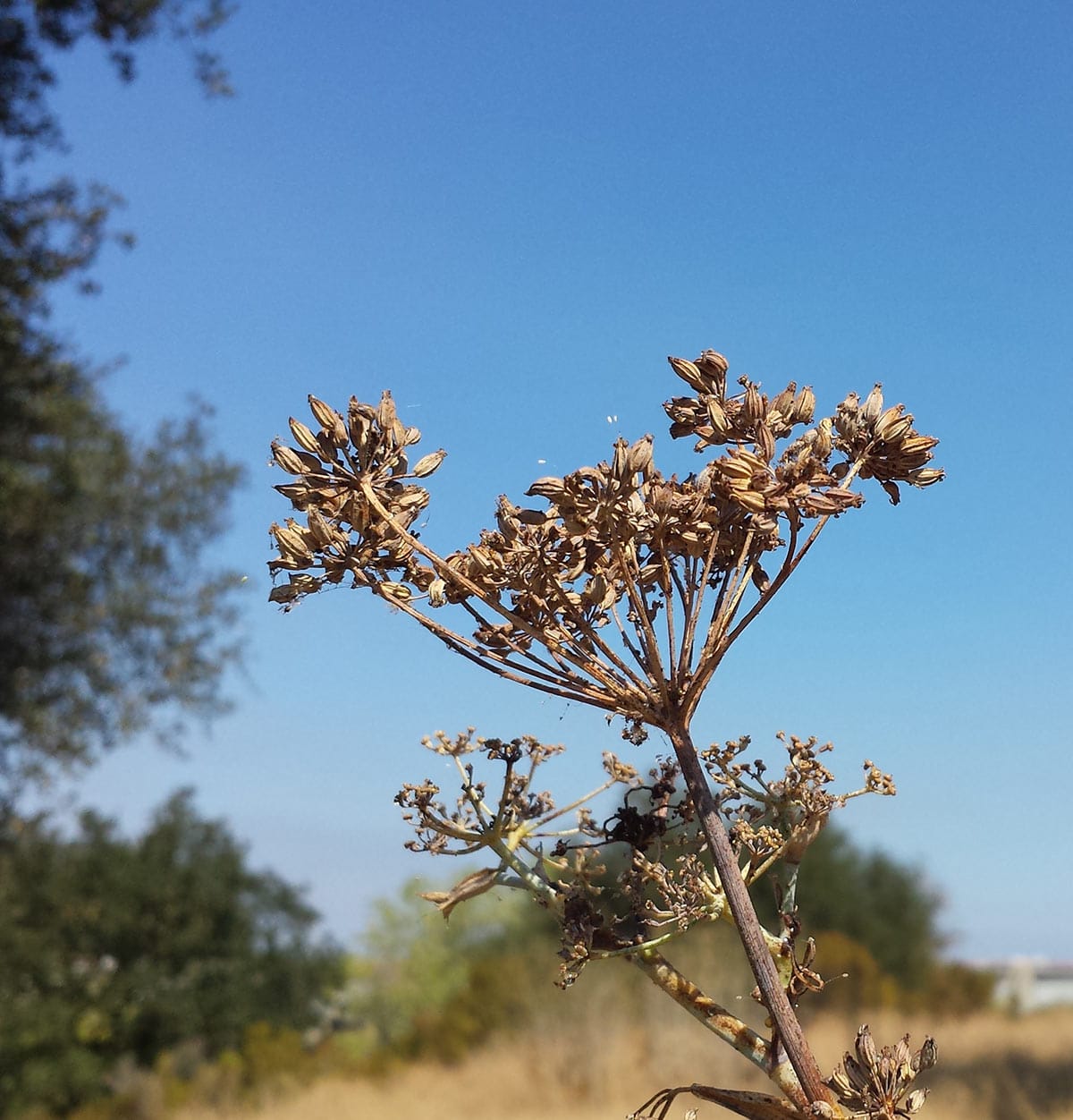
Once you get home, get yourself something to toss the empty seed heads in (compost bag?) and a broad, flat container like a casserole dish or a baking sheet. Take each seed head and remove the seeds from each little cluster with your thumb and forefinger, dropping them into the dish below. The force and motion I use is a lot like wiping something sticky off your fingers. I managed to get 4 ounces of seed in about 25 minutes of doing this.
When all the seed heads are free of seeds, toss them in the compost and turn your attention to the dish of seeds, which will need to be cleaned. I pick through and find all the little clusters that fell in (they look like teeny octopi or spiders) and remove them. It helps to have tweezers. Pick through and remove as many little twigs, bugs and debris as possible.
Finally, put your seed into a jar and freeze it for a week. Why? There might be insect eggs or grown bugs you missed in your seeds, and you don’t want an infestation in your seed. Freezing will kill everything too small to see. Once you’re done with this step, keep your fennel in the spice cabinet. It will last a year or so.
I use dried wild fennel seeds constantly in my cooking, but their highest use, in my opinion, is in making finocchiona, fennel salami.
Wild Fennel Almost All Year
Depending on where you live, wild fennel has something to offer almost all year long. It starts in late winter here in California, spring everywhere else.
Walking around, you will see the skeleton of last year’s growth, probably half blown down by winter storms. But look at the base of the plant and you will see the new growth.
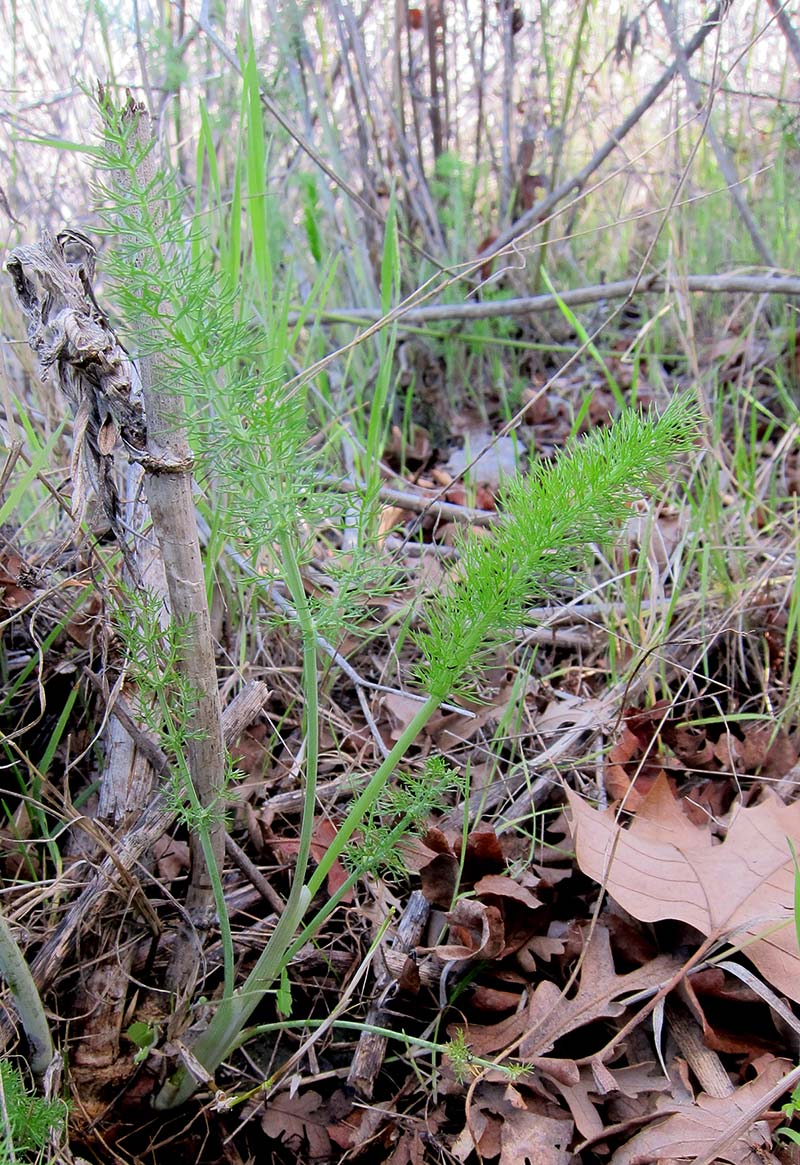
These wispy little shoots are tender, sweet and very flavorful. Use them in salads, stir fries, or wherever you want a fennel punch. This will continue as the plants grow all through spring.
During this time I often make my fennel-tomato pasta sauce to go with pasta. The sauce is sweet and tangy and strong, but not so strong as to mask the fennel’s flavor from the pasta itself.
You can also preserve the fresh stalks and stems of wild fennel by making fennel sauerkraut, which also works well with the bulbs of garden fennel.
Wild Fennel Pollen
High summer is a busy time if you are into wild fennel because the plant is both setting seeds and is in full flower. The flowers can be eaten as a garnish, but their real treasure is fennel pollen.
It is a trendy ingredient, frightfully expensive if you have to buy it. But, you can gather fennel pollen yourself. There are two ways to do it, and each has advantages. The easiest way is to gather lots of fennel flower clusters and put them in a paper bag, tying the bag closed and the stalks together. You then hang this somewhere and as the flowers dry, the pollen drops into the bag.
The plus side of this method is that you don’t have too much work to do. The downside is that you get dried pollen, which is good stuff… but not nearly as wonderful as fresh pollen.
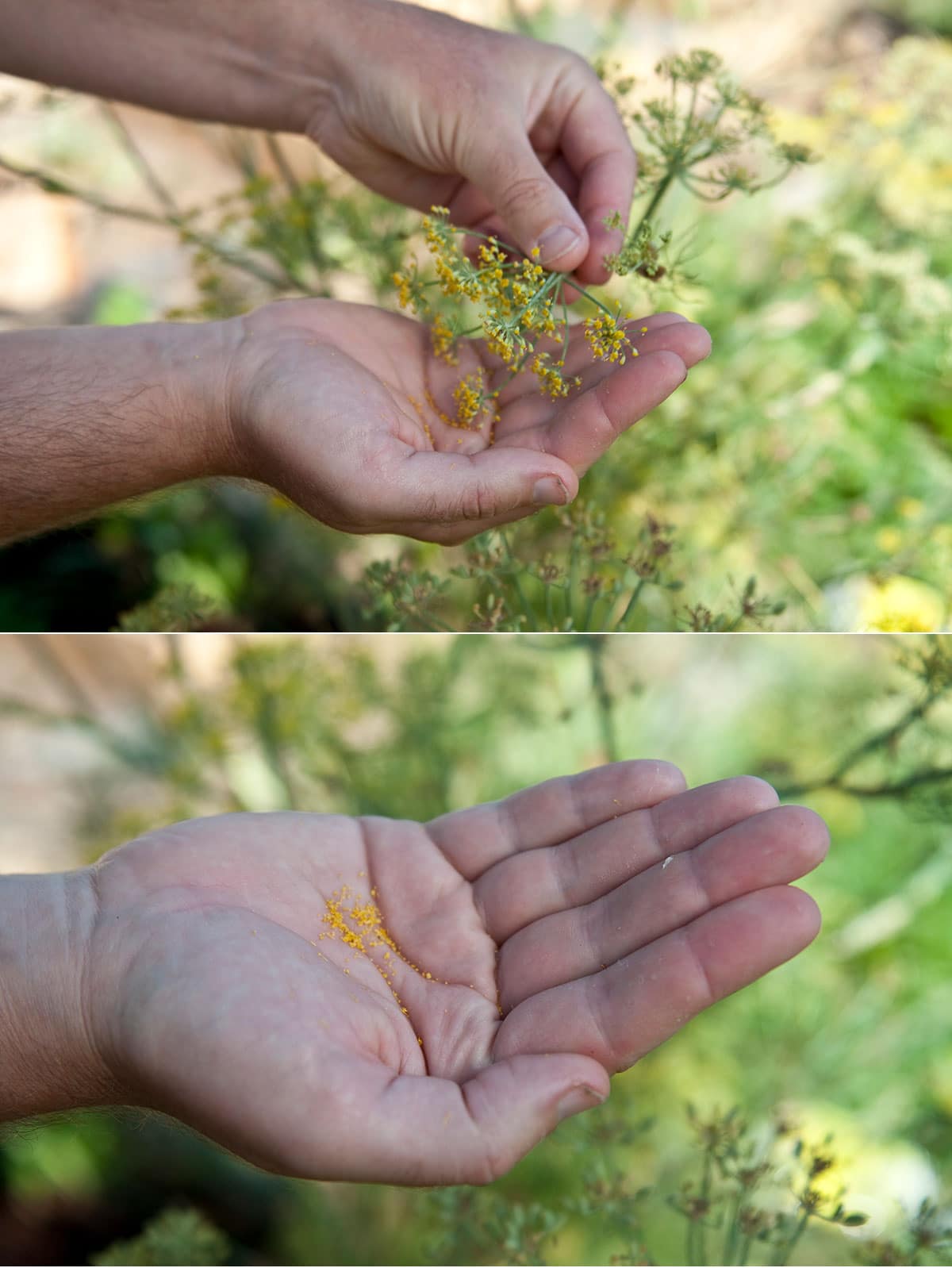
You collect fresh fennel pollen by going to each flower head and shaking it into a bag, dislodging the pollen, which will be a lovely, creamy yellow. Incidentally, this works with either garden or wild fennel.
It’s not easy to collect a lot of fennel pollen, no matter which method you use. Each flower head will only have about a 1/4 teaspoon of fennel at the most.
There is a reason why fennel pollen isn’t cheap. It is easy to gather, but because each flower yields so little pollen, it can take an hour of gathering to collect an ounce. You’ll also get all sorts of creepy crawlies in the pollen, which need to be evicted before you can store it. A few seconds in the microwave kills anything too small to see.
All this work is worth it. Not only is fennel pollen beautiful to look at, it has a beguiling anise flavor that is unlike that of the rest of the plant. The pollen tastes warmer and rounder than either the seeds or the bulb.
How do you use the pollen? All sorts of ways, really. I’ve made an Italian olive oil cake with fennel pollen, used the pollen in soups and sauces, dusted it on meat and fish, and put it in a Greek fennel cookie I call Bacchus Biscuits.
Green Fennel Seeds
These are the hidden treasure of wild fennel. Walking around a patch in July or August, you will see the seedheads ripening. But the seeds themselves remain green for some time. If you eat one, it will be a revelation: Juicy, crunchy, sweet, and very strongly flavored. I love them.
I will gather green fennel seeds just to eat, but I like them on ice cream, too. Green fennel seeds can also be preserved by submerging them in simple syrup. Kept in the fridge, this will last months.
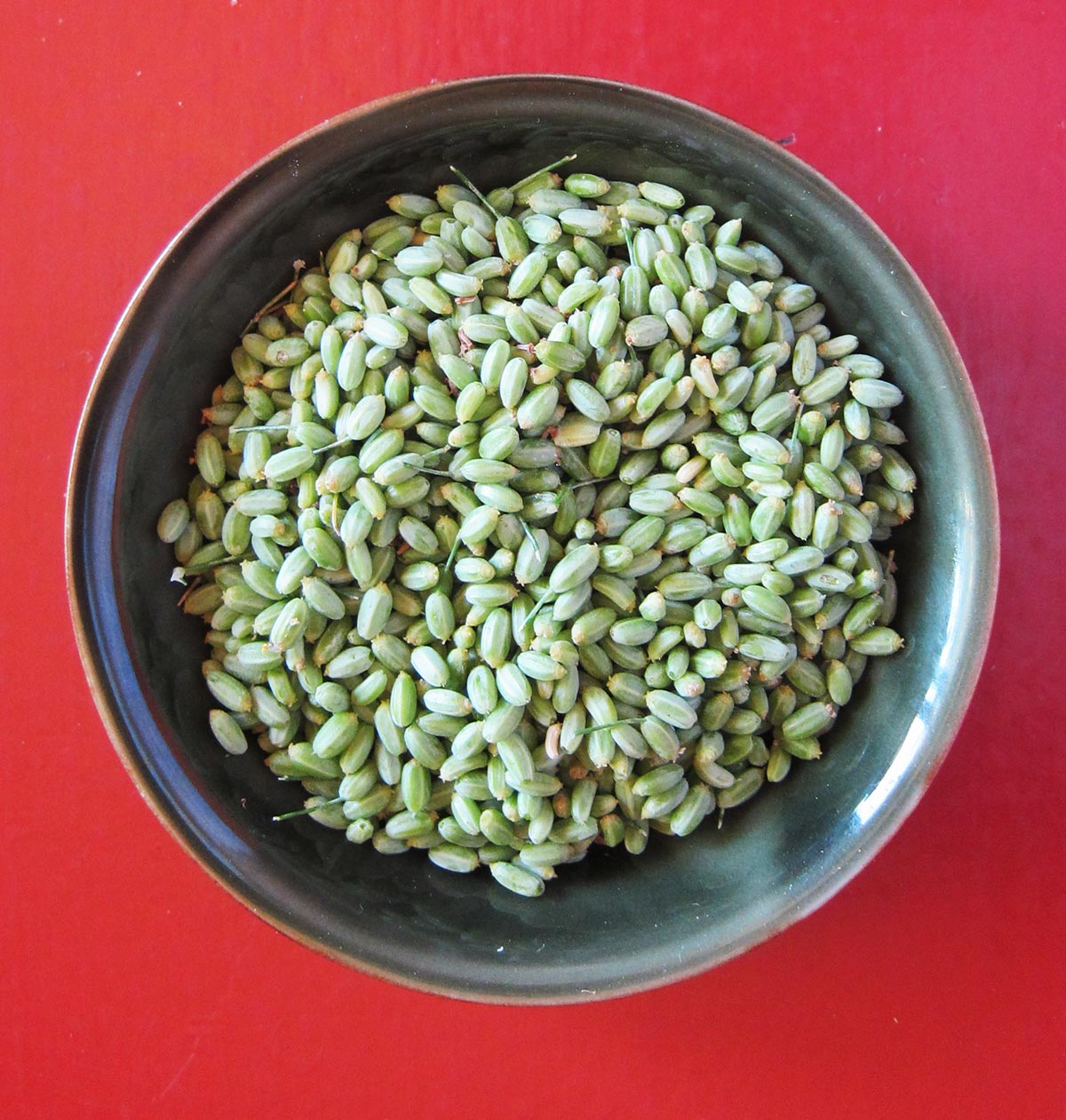
I hope this little tutorial has inspired you to gather some wild fennel. After all, it’s invasive, and eating the invaders is one of the best ways to deal with a pesky plant.
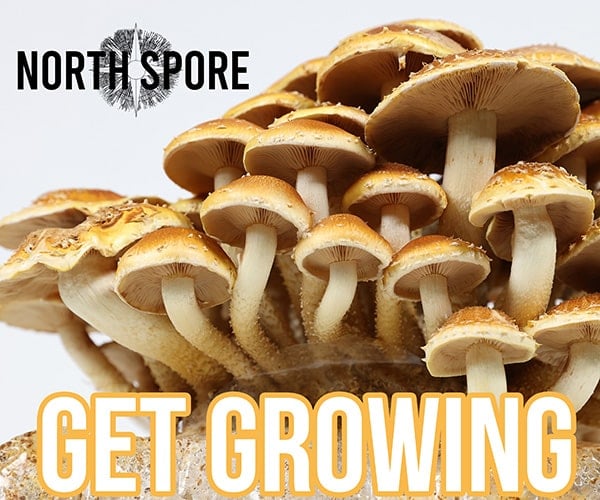
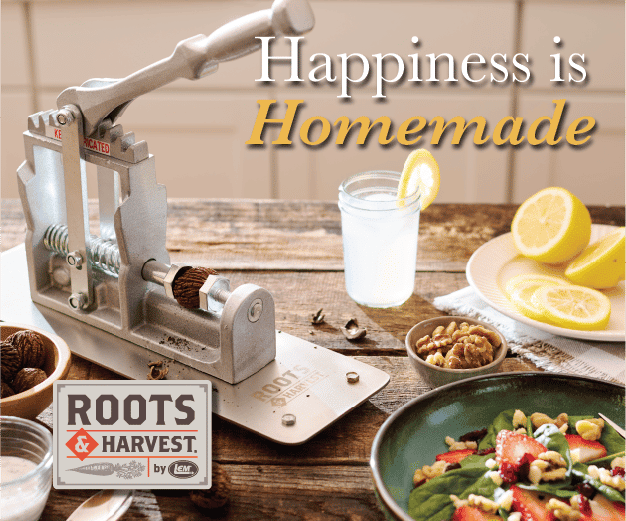
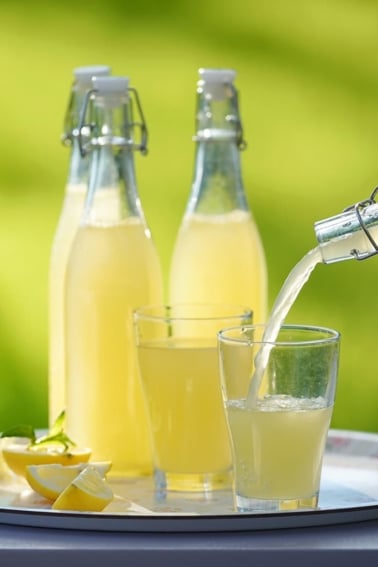
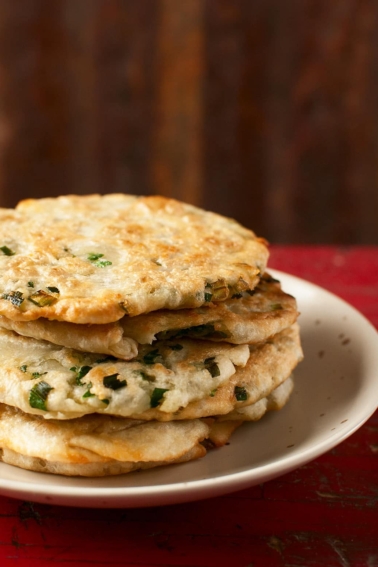

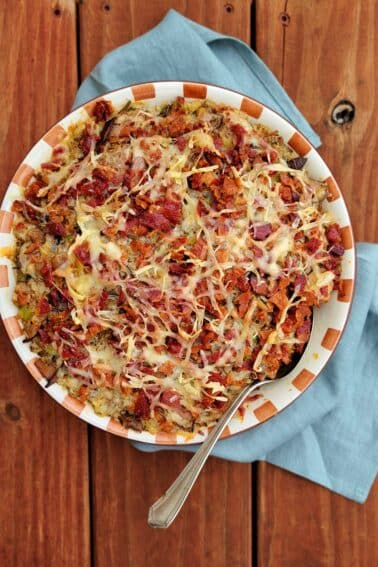
Hank, do you know a way to keep fresh fennel seeds green? I found online a woman who grinds them up with sugar and keeps the fennel sugar in a jar, but no other solutions. Do they freeze well? I like the fresh so much better than the dried seeds. I let bronze fennel spread freely in my gardens… this year, quite a crop! I just used fully ripe seed heads as decor on tables at a reception featuring local foods, with small signs inviting people to try the seeds. I saw little children really enjoying them!
LOVE YOUR RECIPES – am going to try some out before the weekend is over!
I love this website. I learned so much from you. I have only grown bronze fennel but am now going to try the wild kind.
Thanks for the instructions for collecting the pollen. I refused to pay the price they wanted for it when I knew that there must be a way to do it myself.
Sue: You won’t get much pollen from one plant. When I collect I go to dozens of plants to collect it, and I still get less than a 1/2 cup of pollen.
As for the individual flowers, they do seem to replace the pollen because the flowers will set seed.
I am growing an ornamental fennel (in the Boston area) and its just starting to flower now and I was wondering if the pollen with be the same/similar?
Since i do not have a lot of fennel, I would like to maximize the pollen so if I read you correctly I am just going to shake the pollen off but not cut the flower./?
Will the same blossom produce pollen and a few days later yield a bit more?
Lastly, will that same flower later produce seeds too? Thx!! Great article!!! sue
I used Golden Gourmet Pollen – Pork and Poultry Seasoning and Herbes de Provence 1880 Seasoning blend on our Christmas turkey. I ground the seasonings to a fine grind in my coffee grinder and added it to melted butter. We inserted the mixture under the skin of the turkey and rubbed the remainder on the exterior of the bird.
This was an awesome combination and everyone praised the tenderness and flavor of the turkey.
Nate: Fennel pollen is EXCELLENT on poached fish!
I wonder if it can be used on poached fish?
Brent: It has to be dried to be shelf stable. The paper bag is a good way to go. If you want it fresh, keep it in the fridge.
I harvested some fennel pollen last week. Put it in a plastic bag on my spice shelf. Big mistake. A few days later I opened it up to use some and the entire stash was moldy big time!! Any advice on drying the pollen so the wonderful aroma is not degraded? I’m sure I should have used a paper bag, but do you think air-drying is the way to go? Any help in this department would be appreciated…
Recently I made some tzatziki with fennel instead of dill. This went over very well.
Hank, we get a fair number of pigs here in the East Bay Hills, and plenty of fennel there, but I’ve been unable to find a hunting connection. The trappers put a pretty good dent on them around the state and regional parks (which cover most of the hills in my neighborhood), but I know there’s hunting to be had here.
Kinda got my curiousity spiked up now…
Ever inspired by your delicious posts, I stumbled sleepily into my back yard this morning (pre-coffee, even!) to grab some fennel seed to toss into a pasta sauce.
Ran smack-dab into a couple of gorgeous Anise Swallowtail caterpillars, who are now happily snacking fennel fronds in a giant bell jar where we can watch them turn into butterflies (and where the chickens can’t eat them). I love that the sheer abundance of fennel around here means I can share with the local wildlife and still have more than enough for myself!
Thanks again for your recipe – I’ll be making fennel pollen pasta soon, I’m sure. It sounds delicious.
Christine: Strike while the fennel is in bloom! And I also love thinly shaved fennel salads in summer.
Phillip: Never knew that, but it’s pretty cool. I don’t think there are enough wild pigs where the fennel is most widespread – the Bay Area – to get a “fennel hog.” But it’d be one tasty pig if we found one!
Carolina: I pickle fennel every year. I’ve never grilled it though. Will give it a go.
Lara: Do you mince the fennel fine? How does everything come together as a sauce?
Ken: You know where I live. Send me summa dat salami!
Frances: I’ve that baked fennel dish before, but I like the idea of a stewed, julienned fennel dish spiked with sun-dried tomatoes….
I love the way you describe your adventure with fennel! I use the bulbs often since I can buy the Italian bulbs. I prepare them fresh in a salad sliced with red onion and orange segments covered with an olive oil and lemon dressing with black pepper and very little salt. I stew them, julienned, in olive oil together with 2 or 3 chopped dried tomatoes. Very interesting flavor is the result. Also, cooked bulbs (I always put lemon juice in the water to help the taste come out) sprinkled with grated parmesan and baked in the oven, is a wonderful combination.
Signor, Again we are on the same wavelength. Just made a salame with fennel pollen yesterday. It was actually an ingredient in the 16th century, Scappi used it all the time. Especially with pork. Gorgeous combo. Mangia!
fennel pollen pasta? That sounds really really good. I like to cook some fennel bulb in butter and white wine, then add smoked salmon and some cream, for a simple pasta sauce.
Grilled fennel is a favorite…used in a warm salad or with some fish.
Raw in just about anything.
Thinly sliced and ‘pickled’ like you’d pickle red onion. Killer on a sandwich…also nice with a diver duck pate.
I wonder if I can get some ‘wild’ fennel sprouting up around here…
Thanks for reminding me to plant some dill weed seed later today. It’s the only herb that I know of that will sprout from seed in the high heat of summer. It’s popping up everywhere right now — except in the places that I want it.
Fennel is supposed to be a favorite of the wild pigs, and I’ve even heard some native plants ecologists cursing it because it’s not only an invasive non-native, but it tends to bring pigs into new areas.
Personally, I’ve always wondered if they’d eat enough to affect the meat quality (like deer or antelope in sage), but I seldom see much wild fennel in the areas where I pig hunt, so I haven’t found out first hand.
I’m kicking myself for never bothering to collect the fennel pollen that grows wildly along the hills in Sausalito when I had the chance. There were so many tall unrelenting stalks! I’ve never tried a dish with fennel pollen, but would sure love to see what the buzz is all about.
My favorite way to prepare fennel is shaved thinly in the summers, and oven roasted in the winters.